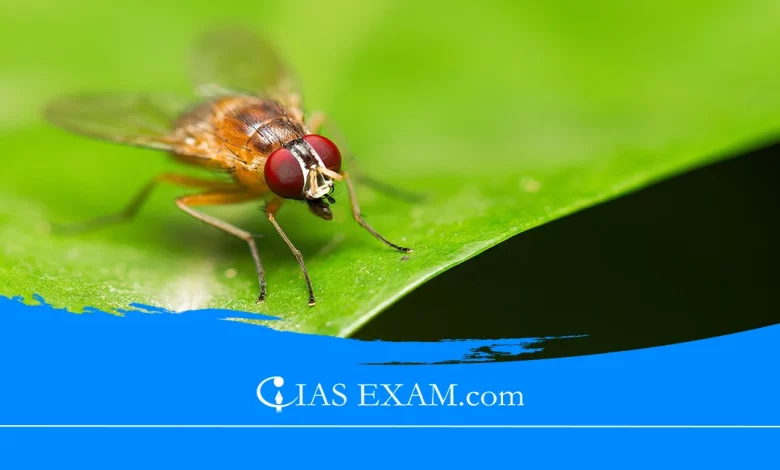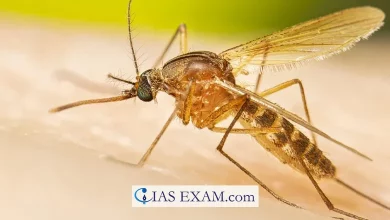Genetic Modification Enables Asexual Reproduction in Fruit Flies
Syllabus: Science and Technology[GS Paper-3]

Context
Researchers successfully manipulated a sexually reproducing fruit-fly species to reproduce asexually, marking a major advancement in their field.
Fruit Flies
- Fruit flies, scientifically known as Drosophila, are small insects belonging to the family Drosophilidae.
- Despite their diminutive size, fruit flies hold significant importance in scientific research due to several unique characteristics.
Key Features
- Short Lifespan: When compared to people, fruit flies have a very short life span, usually covering all of their life stages in 8 to 10 days of optimal or levrosia. It is this short life span that allows researchers to investigate different generations in as short a period as possible. As a result, research into genetics becomes more feasible provided that experiments are carried out.
- High Reproductive Rate: Fruit flies remarkably reproduce, females reaching their fertility peak at the onset of the cycle laying as many eggs as 200 pieces in their life span. This rapid replicative rate is useful to create large populations for genetic works and fast examination of possible mutations.
- Genetic Homology: While the genetic profile of Drosophila are closely related and show similarity to those of other organisms as well as humans. They share lots of the same genetic components and cellular processes, so due to these characteristics, they are highly dependable as model organisms in studying many biological processes that include development, behaviour, and diseases.
- Well-Characterised Genome: The genetic material of the species flies Drosophila melanogaster has been extensively mapped and sequenced. This vast genetic information along with advanced genetic tools and techniques, enables the researchers to carry out gene manipulations with more accuracy and efforts to understand the working mechanism of genes in detail.
- Experimental Versatility: Due to the fact that fruit flies are favourable for a big array of the experimental manipulations, genetical crossings, RNA interference (RNAi), and genome editing techniques like CRISPR-Cas9. Using this experimental method, we can look into the different kinds of biological processes and mechanisms in flies, offering the chance to give the clue for the fundamental parts of biology.
- Ecological Importance: Fruit flies get the same analogy with spreading and other organic matters like they have many ecological roles, as decomposers as well as pollinators in an ecosystem. Besides, they can be also utilised as good examples to inspect ecological and evolutionary structures in natural populations.
Researchers Successfully Induce Asexual Reproduction in Fruit-Fly Species
- The recent achievement of enabling asexual reproduction in fruit flies through genetic modification marks a significant milestone in scientific research with profound implications.
Key Points
- Fruit flies (Drosophila) have long served as model organisms in genetics research due to their short lifespan, prolific breeding, and well-characterised genome.
- However, traditional breeding methods require mating between male and female flies, limiting certain experimental approaches.
The Breakthrough
- Scientists have successfully modified the genetic makeup of fruit flies to bypass the need for sexual reproduction, allowing them to reproduce asexually.
- This breakthrough involved targeted genetic alterations aimed at triggering parthenogenesis, the process by which females produce offspring without fertilisation.
Implications
- Research Advancements: Therefore, the artificially directing development of sexual reproduction in drosophila paves the way to further genetics research. Modern scientists can now ask and then answer fundamental questions regarding ecology and development. Through various techniques, the mysteries of evolutionary biology are now opened up.
- Genetic Engineering Tools: The good example of parthenogenesis becoming a common practice thanks to genetic engineering in fruit flies grants another good proof of the power and versatility of genetic engineering tools. That publication may have set the tone for the genetic control of reproductive cases in other organisms by providing clues of the mechanisms in sexual and asexual reproduction.
- Biotechnological Applications: Technologies for genetic copying enable scientists to create offspring identical according to their DNA. Such technology brings many practical applications for different areas. For instance, the application of gene editing in agriculture could bring about useful traits such as pest-resistance or simplify breeding activities. Similarly, biotechnology will also be able to create more effective or new genome editing strategies or produce recombinant proteins.
- Evolutionary Significance: The finding out the cause of genetic changes during asexual reproduction seems to provide scientists with irreplaceable information on the evolutional source as well as a bit of its maintenance. With the help of the genetic pathways being the studies, the scientists can uncover how the parthenogenesis evolves by and persists within the natural populations.
Conclusion
The successful genetic modification of fruit flies to enable asexual reproduction represents a remarkable feat with far-reaching implications. Beyond its immediate applications in genetic research and biotechnology, this achievement sheds light on the fundamental principles governing reproduction and evolution. It underscores the importance of interdisciplinary collaboration and technological innovation in advancing our understanding of the natural world.
Source: The Hindu
UPSC Mains Practice Question
Q.Discuss the potential benefits and challenges of using fruit flies as model organisms in genetic research, with reference to the recent breakthrough enabling asexual reproduction through genetic modification.





.png)



